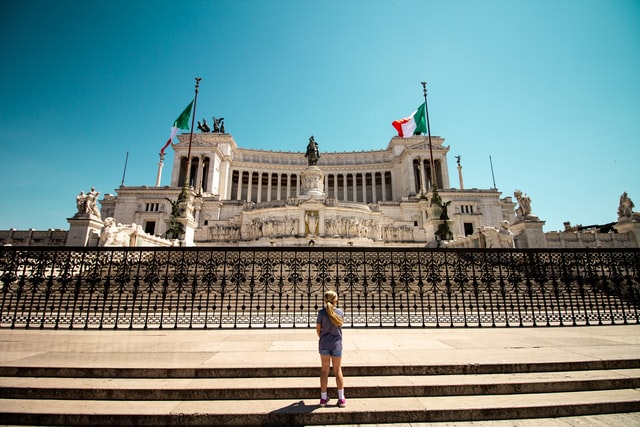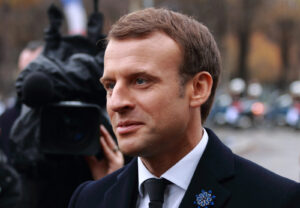The Italian political scene
There are currently five main political parties in Italy: The Democratic Party (PD), Brothers of Italy (FdI), The League, Five Star Movement (M5S), and Forza Italia (FI).
The Democratic Party (PD) is a center-left, social-democratic political party. The party supports progressivism, green issues, and progressive taxation. The PD is also pro-European and in favor of the social integration of immigrants.
Brothers of Italy (FdI) is the principal heir of an Italian neo-fascist conservative movement. It is a far-right, nationalist and conservative party led by Giorgia Meloni. It aims to introduce stricter rules regarding illegal immigration and is historically Eurosceptic. The party is openly against LGBTQ rights and seeks to strengthen Italy’s relations with Russia.
The League is a right-wing, populist, conservative, and federalist political party led by Matteo Salvini. This party has conservative views regarding abortion, same-sex marriages, euthanasia, and stem cell research. The League openly supports Judeo-Christian values and favors stricter measures regarding immigration laws. This party has close ties with the Israeli government and Russia.
The Five Star Movement (M5S) is a populist movement with Giuseppe Conte as president and favors the participation of all citizens in politics through digital democracy. M5S supports green issues and LGBTQ rights. Regarding immigration laws, the party has been ambiguous, at times promoting stricter measurements. Historically, the movement has been Eurosceptic, although it has recently changed its position.
Forza Italia is a center-right, liberal, conservative party with a Christian democratic ideology. The party has conservative views on same-sex marriages and seeks to limit abortion and euthanasia. The party aims to develop and create close ties with the European Union, the United States, and Russia.
Italy in the 1990s and the beginning of the 21st century
Since the beginning of the Second Italian Republic in 1994, Italy has been governed by two main political coalitions: Center-left coalitions known first as “The Olive Tree” and then “The Union” around the Democratic Party, and a center-right coalition, with the main party being Forza Italia (FI) led by Silvio Berlusconi.
For most of the 2000s, Forza Italia was the main political party running the country. That continued until Berlusconi was forced to resign in 2011. The following years were particularly complex for the Italian political scene, and four different cabinets quickly followed each other. Finally, in 2018, two populist movements won the elections, the Five Star Movement (M5s) and the League, starting the Conte Cabinet.
In February 2021, Conte was forced to resign. Mario Draghi, the former European Central Bank President, was chosen as Prime Minister under the pressure of the Italian President, Sergio Mattarella. Mattarella’s role is very limited according to the Constitution but he intervened to push for creating a national unity government consisting of a broad coalition of all the parties in the legislature.
The management of the pandemic and its consequences
The objective of the Draghi Cabinet since then has been to efficiently manage the health crisis caused by Covid-19 and mitigate its economic impacts.
Concerning the Covid-19 pandemic, after a terrible year in 2020, Italy’s government has successfully controlled the epidemic in 2021 compared to neighboring countries. The government put in place a series of laws that led 86.80% of the population to complete two shots of the vaccine. However, at the beginning of 2022, a fifth wave hit Italy, and a “super health pass,” in fact, a vaccination pass, is now a condition to access most activities. A negative test is required on arrival for all travelers, and those who are not vaccinated must undergo a quarantine.
The Italian economy was in crisis before the pandemic, with one of the lowest growth rates in the EU since the 1990s, along with a high level of debt. But Italy could benefit from the crisis, as it is the first beneficiary of the vast recovery program financed by the European Union. The amount allocated to each member state has been calculated according to the impact of the pandemic on its economy. As Italy has suffered greatly, with a 9% drop in GDP, in 2020, it has been allocated 191.5 billion euros, including 69 billion euros in subsidies.
As a counterpart to this help, the Italian PNRR (Recovery and Resilience Plan) consists of a series of reforms to improve the country’s digitalization, speed up the green revolution, build new infrastructure, and support the health system, as well as education and research sectors. In particular, the government has worked on several reforms modernizing the drastically slow Italian justice system and increasing the retirement age from 62 to 64. At the end of 2021, Mario Draghi declared that the Italian government had achieved all the 51 objectives stated in the PNRR and that the country’s economy had started to grow again.
The foreign policy
Despite its chronic political instability and financial fragility, Italy is the third-largest economy in the eurozone and remains a rich country. It has a powerful export model and was the eighth largest economy in the world in 2020. Moreover, it has been one of the six founding members of the European Union, recognized for its cultural heritage, which has often contributed to European civilization since the Roman Empire.
The country’s foreign policy is based on multilateralism, and Italy remains one of the largest contributors to the budgets of the European Union and the United Nations. It participates in all major international forums, especially the G7 and the G20. In 2021, Italy had the presidency of the G20. It has developed relations with China through its participation in the “Belt and Road Initiative (BRI)” in March 2019, being the first G-7 country to participate in the Chinese project. This has been controversial, and its results are not always what was expected, even if it has formalized the relations between the two countries.
The relations with France have always been very close, for geographical, cultural, and political reasons, with periods of tensions, or, as it is the case now, with a close collaboration between the governments. In 2020, a European Recovery Plan idea was born out of a Franco-Italian initiative by French President Emmanuel Macron and Italian Prime Minister Giuseppe Conte. Together, they lobbied to convince Angela Merkel to go along with it. As a result, on November 26, 2021, Italian Prime Minister Mario Draghi and French President Emmanuel Macron signed the Quirinal Treaty. This treaty consists of 13 articles promoting the convergence of Italy and France. The Quirinal Treaty also encourages the coordination of these two countries in European matters and other policies including, economy, migration, defense, research, and culture.
What Lies Ahead
Italian lawmakers have recently re-elected Mattarella as President of Italy, thus preserving the status quo and avoiding early elections if Mario Draghi had been elected. Before the elections, Mattarella had made it clear that he did not want to serve another mandate. However, when the lawmakers voted for him, he was forced to accept. Given his 80 years of age, some people believe that Mattarella will resign after the end of the Draghi Cabinet in 2023, but these are only speculations.
This election has severely weakened Italy’s center-right coalition. Salvini, from the right-wing party The League, failed to impose a more conservative president, and it is becoming evident that many members of his party are slowly losing trust in him. Meloni, the leader of the nationalist party Brothers of Italy, heavily criticized Salvini’s leadership, and it seems that some of the members of the League are considering a switch to Brothers of Italy. According to a poll by LA7, one of the leading Italian TV channels, on January 24, Brothers of Italy had an approval rating of 19.8%, superior to the 18.4% approval rating of the League. The center-right coalition is also weakened by what’s currently happening in Forza Italia, with Berlusconi slowly losing its leadership due to its age. The other party members seem to have fewer radical ideologies than both Meloni and Salvini and seem disoriented.
The Five Stars movement M5S is currently experiencing an internal crisis. The president of the movement, Conte, has strengthened his ties with the more radical members of the party in contrast with the Minister of Foreign Affairs, Di Maio, who is a moderate. This may cause a split within the party, which has an approval rating of 13.5%.
The Democratic Party was extremely united in its vote for Mattarella and remained the party with the highest approval rating (21.7%).
Even if the 2023 elections remain far away, it seems that the Brothers of Italy and the Democratic Party may emerge as the winners. Although with two contrasting ideologies and almost nothing in common, both parties have a chance to win the upcoming elections. They cannot organize a coalition together, which may lead to a volatile situation in the country.




